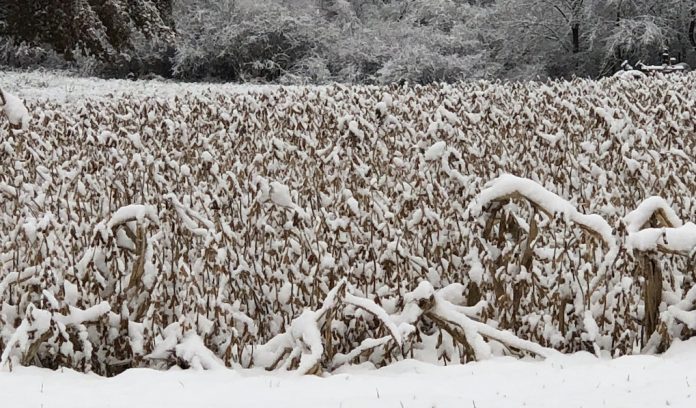Recently I saw an adorable picture of a toddler all bundled up in her snowsuit trying to catch a snowflake on her tongue. Her eyes were crossed and her tongue was outstretched as she concentrated on the task.
It reminded me of an adage my grandma always said. She often warned me, “Don’t cross your eyes, they will get stuck that way.”
I lived in fear of being cross-eyed forever.
Some adages have a baseline of truth, but I don’t think anyone managed to glue their eyes crossed.
I stumbled across another old saying the other day when I was reading Farmer Boy by Laura Ingalls Wilder with my son. The book tells the story of Laura’s husband, Almanzo, growing up on a farm in upstate New York in 1866. His father told him snow was a good thing and called it “poor man’s fertilizer.” It made me stop and think about how snow could be considered fertilizer.
Scientific explanation
As it turns out, there is an explanation rooted in science for that expression. The clarification of the idiom begins by looking at the composition of Earth’s atmosphere. It is largely nitrogen at 78%; the other remaining elements are oxygen at 21%, argon at 0.9% and 0.1% other gasses.
However, nitrogen is only usable by plants and animals after a process called nitrogen fixation. The electrical energy in a bolt of lightning is strong enough to break apart the two atoms in a nitrogen molecule. Then the nitrogen atoms bond with oxygen in the atmosphere to form nitrogen dioxide.
Nitrates are the result of nitrogen dioxide dissolving in moisture in the clouds. Precipitation pulls the nitrates down to the ground creating poor man’s fertilizer. Rain and snow both contain nitrogen, but snow by its nature provides a better delivery method. Nutrients are slowly released into the soil as the snow melts. This is especially effective early in the spring when the ground is thawed.
During rainfall, nutrients are washed away before they can be fully absorbed into the soil. Snow has another added benefit as an insulator. Plants and soil are protected from wind and freezing temperatures.
The most prevalent process for nitrogen fixation occurs in the root nodules of legume plants. Legumes like peas, beans, locust trees have a symbiotic relationship with bacteria called rhizobia.
Within nodules formed on the plants’ roots, the bacteria take gaseous nitrogen from the air and soil to feed the legumes. In return, the legumes supply carbohydrates to the bacteria. People then consume the plants or the animals that have eaten the plants.
Too much
Another old saying dates back to the 15th century and was even used by Shakespeare and as song lyrics by Alan Jackson. “Too much of a good thing” can be applied to snowfall and nitrogen.
A large percentage of synthetic nitrogen is evaporated into the air or washed away by rain. It has increased crop yields but has an adverse effect on forests and waterways. Scientists are working to find a balance between the pros and cons.
As freezing temperatures and heavy snowfall arrived this season, many people recalled the infamous blizzard of 1978. The blizzard is definitely an example of too much of a good thing.
Up to 40 inches of snow and winds up to 100 mph characterized the storm of the century. Record-setting barometer readings and severe wind chills created catastrophic conditions claiming the lives of 51 people in Ohio.
Throughout history and across many cultures, people encourage each other with four simple words, “this too shall pass.” The Persian saying is a gentle reminder that even after the starkest winter, spring finally bursts forth bringing sunshine and flowers.
When I look at the snow now well over a foot deep, I will think of my flowers, well insulated in the nutrient-rich soil just waiting for the perfect time to finally emerge.














Your scientific explanation of nitrogen in snow and the atmosphere is so helpful, especially as it relates to the old adage. Laura & Almanzo Wilder we’re lifetime farmers and long before Laura wrote the Little House books she was a columnist for a farm journal called The Missouri Ruralist. There she wrote an article about “the fairies” that make gardens grow – showing her whimsical, childlike side and relating it to the nutrients needed for good farming. I think that’s what makes her children’s novels so readable: blending the wonder of nature with reality. Thanks again!
Thank you for the extra information! I learned something new about L.I.W from your comment. I thought it was a fun coincidence that this was published within a week of her birthday, 155 years later. She definitely has a whimsical side; I agree it makes her books very enjoyable to read. She has sparked an interest in the pioneer age since her books were published.